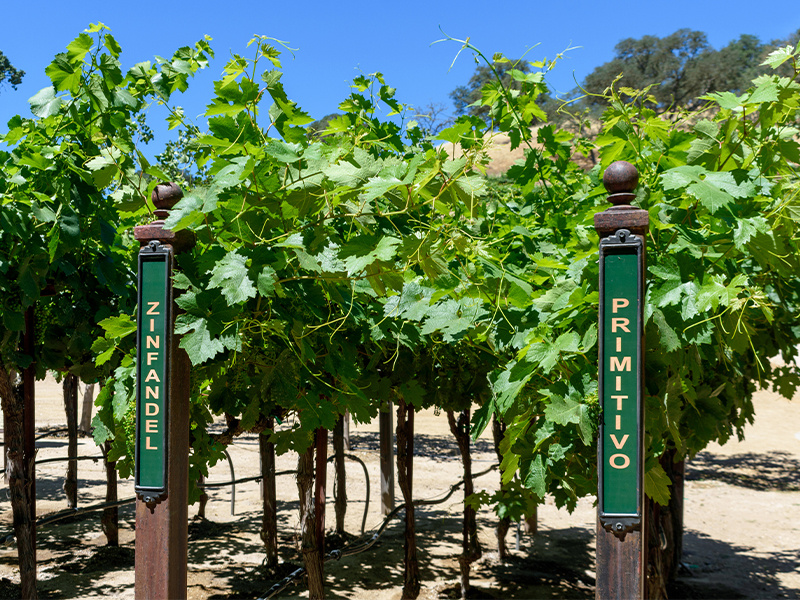Is it Zin or Primitivo…Siblings or Cousins?
- Posted on
- Posted in California, croatia, Italy, zinfandel
- 0

The featured wines this week include Zinfandels and Primitivos; a great example of New-World versus Old-World wine. You might be saying, “Wait. Are not they the same grape?” They were once considered the same grape, or perhaps siblings, and then some further testing and research suggested they may be different.
Several years ago, a blog titled Primitivo vs. Zinfandel vs Tribigdrag, was written on the “definition”and comparisons of Zinfandel and Primitivo. As a recap, there is somewhat of a controversy over Zinfandel and Primitivo. It seems to be an ongoing controversy. In fact, if you do an online search, you will find several articles stating that they are the same and almost an equal number of articles that suggest they are slightly different. In fact, one winery states that they have both grapes planted next to each other and are completely different in appearance and nature. Genetically, these two grapes are extremely similar—DNA research shows that Primitivo and Zinfandel are both clones of a Croatian grape called Crljenak or Tribidrag. It is quite possible, just as with other grapes there are several different clones of the same grape. The differences in the name are where they are grown, as the names are not always interchangeable on the label. European wineries may call Primitivo “Zinfandel,” and vice versa, but American wineries may not. In 2002, a proposal was made to allow the names to be interchangeable in the United States, but it has not been acted on. Yet. The differences are typically (not always) in the winemaking style, where Primitivo is handled Old-World style, and in California, is handled New-World. So, what does that mean?
Old-World versus New-World, what does that really mean? It is more about traditions than anything else. Old-World wine tends to have lighter body, lower alcohol, higher acidity, and less jammy flavor, with more minerality. The winemaking style is less manipulation and more traditional and terroir-driven. Traditions and reflecting terroir is more important than is maintaining the same taste profile from vintage to vintage. New-World wine tends toward fuller body, high alcohol, lower acidity, and pronounced fruit flavors. This style generally follows the same profile from year to year; with the style and profile being the priority over tradition and heritage.
It makes sense that Zinfandel, typically grown and produced in California, would be considered New-World. It follows the characteristic style of being a little higher in alcohol, fruit-concentrated, and less acidic. Zinfandels from California might also be blended with other grapes like Petit Sirah and Carignane, to add to body, acid, etc. Whereas in California winemakers have the flexibility to handle the winemaking process, in Italy to be labeled as a Primitivo, it must follow the regulations set forth if the winery wants to maintain their designation. Wine regulations are based on tradition, or Old-World.
This week at the store, you will be able to taste Old-World and New-World. Frey Vineyards utilizes a biodynamic process, which is commendable, as to be biodynamic goes a step beyond that of organic. The regulations to be labeled “biodynamic” are quite laborious and stringent. Frey’s winemaking process is somewhat a combination of New-World and Old-World, as they incorporate modern winemaking with traditional winemaking. As was done in original winemaking, they do not use any sulfites or synthetic additives. They start with premium certified organic grapes. As in Old-World wines, their wines are not manipulated to reach a certain profile, each vintage is specific to site and environment. Going just a step away from the combination of Old-World/New-World, there is Carol Shelton Wild Thing Zinfandel Old Vine, Mendocino County. It goes through fermentation uninoculated, relying on wild yeast from the organic vineyard to create a terroir-driven complexity, yet also incorporates some blending for a certain profile.
From Old/New-World move on to Old-World from Puglia, Italy. The Petraio Primitivo is harvested by hand, from vineyards aging 15-18 years with southern exposure. Ten days of maceration is followed by fermentation using cultured yeast, and no artificial additives are used\. The result is a fresh, fruity, and fragrant wine, with notes of red berries and spice. It is round and supple, with ripe tannins and balanced acidity. The Varvaglione Papale Primitivo di Manduria, is from Primitivo grapes harvested by hand from the oldest vineyards, located near the Ionian Sea in Salento. Unlike the Petraio, the Papale sees Malolactic fermentation, and then is aged in French oak barrels for at least eight months. The production process is aimed at full varietal expression of the grape’s heritage in Manduria.
Come taste through the lineup this week, and see if you find a difference in the labels. Or, a better idea: Grab two bottles of Primitivo and two bottles of Zinfandel and do a blind tasting. See if you can determine where Old-World was applied, and the differences from the New-World style. Cheers!

Comments
Be the first to comment...